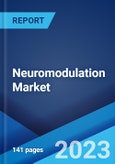The global neuromodulation market size reached US$ 6.7 Billion in 2022. Looking forward, the publisher expects the market to reach US$ 12.5 Billion by 2028, exhibiting a growth rate (CAGR) of 10.4% during 2023-2028.
Neuromodulation is a medical technique used for the modulation and alteration of nerve activities by delivering electrical or pharmaceutical agents directly to the targeted area. It consists of tiny electrodes that generate electrical stimulation with the help of pulse generators to supplement neurological activities in the patients. The electrodes are generally placed in the nerves, brain, or spinal cord, whereas pulse generators are implanted within the skin. Neuromodulation is widely used to treat depression, chronic pain, epilepsy, tremor, migraine, failed back syndrome, Parkinson's disease, and gastroparesis. It includes the vagal nerve, deep brain, transcranial magnetic, and electrical stimulation. It assists in monitoring nerve activity, alleviating symptoms, and normalizing activity levels in the brain.
Neuromodulation is a medical technique used for the modulation and alteration of nerve activities by delivering electrical or pharmaceutical agents directly to the targeted area. It consists of tiny electrodes that generate electrical stimulation with the help of pulse generators to supplement neurological activities in the patients. The electrodes are generally placed in the nerves, brain, or spinal cord, whereas pulse generators are implanted within the skin. Neuromodulation is widely used to treat depression, chronic pain, epilepsy, tremor, migraine, failed back syndrome, Parkinson's disease, and gastroparesis. It includes the vagal nerve, deep brain, transcranial magnetic, and electrical stimulation. It assists in monitoring nerve activity, alleviating symptoms, and normalizing activity levels in the brain.
Neuromodulation Market Trends:
The rising geriatric population and the increasing prevalence of Alzheimer's and Parkinson's diseases across the globe are key factors driving the market growth. Neuromodulation is widely used to treat overactive bladder, low movement, rigidity, tremor, walking problems, neurodegenerative, and neurological disorders. Moreover, technological innovations, such as the introduction of lithium-ion (Li-ion) batteries that provide high energy density, rechargeability, and enhanced cycling temperature, are providing a considerable boost to the market growth. Additionally, the widespread utilization of spinal cord stimulation (SCS) in various medical problems, such as complex regional pain syndrome, neuropathy, nerve damage, failed-back surgery syndrome, and arachnoiditis, is positively impacting the market growth. Apart from this, the increasing usage of deep brain stimulation (DBS) that delivers low bipolar or monopolar electric impulses and is used in the treatment of depression and obsessive-compulsive disorders (OCD) is creating a positive outlook for the market. Other factors, such as extensive research and development (R&D) activities and significant growth in the healthcare industry, are anticipated to drive the market toward growth.Key Market Segmentation:
The publisher provides an analysis of the key trends in each sub-segment of the global neuromodulation market report, along with forecasts at the global, regional and country level from 2023-2028. The report has categorized the market based on technology, biomaterial and application.Breakup by Technology:
- Internal Neuromodulation
- Spinal Cord Stimulation (SCS)
- Deep Brain Stimulation (DBS)
- Vagus Nerve Stimulation (VNS)
- Sacral Nerve Stimulation (SNS)
- Gastric Electrical Stimulation (GES)
- External Neuromodulation
- Transcutaneous Electrical Nerve Stimulation (TENS)
- Transcranial Magnetic Stimulation (TMS)
- Others
Breakup by Biomaterial:
- Metallic Biomaterials
- Polymeric Biomaterials
- Ceramic Biomaterials
Breakup by Application:
- Parkinson's Disease
- Epilepsy
- Depression
- Dystonia
- Pain Management
- Others
Breakup by Region:
- North America
- United States
- Canada
- Asia-Pacific
- China
- Japan
- India
- South Korea
- Australia
- Indonesia
- Others
- Europe
- Germany
- France
- United Kingdom
- Italy
- Spain
- Russia
- Others
- Latin America
- Brazil
- Mexico
- Others
- Middle East and Africa
Competitive Landscape:
The competitive landscape of the industry has also been examined along with the profiles of the key players being Abbott Laboratories, Bioventus Inc., Boston Scientific Corporation, Helius Medical Technologies, Integer Holdings Corporation, LivaNova PLC, Medtronic plc, MicroTransponder Inc., Neuronetics, NeuroPace Inc., NeuroSigma Inc., Nevro Corp.Key Questions Answered in This Report:
- How has the global neuromodulation market performed so far and how will it perform in the coming years?
- What has been the impact of COVID-19 on the global neuromodulation market?
- What are the key regional markets?
- What is the breakup of the market based on the technology?
- What is the breakup of the market based on the biomaterial?
- What is the breakup of the market based on the application?
- What are the various stages in the value chain of the industry?
- What are the key driving factors and challenges in the industry?
- What is the structure of the global neuromodulation market and who are the key players?
- What is the degree of competition in the industry?
Table of Contents
1 Preface3 Executive Summary11 Value Chain Analysis13 Price Analysis
2 Scope and Methodology
4 Introduction
5 Global Neuromodulation Market
6 Market Breakup by Technology
7 Market Breakup by Biomaterial
8 Market Breakup by Application
9 Market Breakup by Region
10 SWOT Analysis
12 Porters Five Forces Analysis
14 Competitive Landscape
Companies Mentioned
- Abbott Laboratories
- Bioventus Inc.
- Boston Scientific Corporation
- Helius Medical Technologies
- Integer Holdings Corporation
- LivaNova PLC
- Medtronic plc
- MicroTransponder Inc.
- Neuronetics
- NeuroPace Inc.
- NeuroSigma Inc.
- Nevro Corp.
Methodology

LOADING...
Table Information
| Report Attribute | Details |
|---|---|
| No. of Pages | 141 |
| Published | September 2023 |
| Forecast Period | 2022 - 2028 |
| Estimated Market Value ( USD | $ 6.7 Billion |
| Forecasted Market Value ( USD | $ 12.5 Billion |
| Compound Annual Growth Rate | 11.0% |
| Regions Covered | Global |
| No. of Companies Mentioned | 12 |








